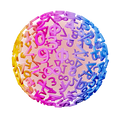How to Reflect About a Line
Video Crash Courses
Want to watch animated videos and solve interactive exercises about mirror symmetry?
When you reflect a figure, you draw its mirror image. A figure has a mirror image just like you do—you can imagine looking at yourself in the mirror in the morning. Now, you’ll learn how to draw these kinds of mirror images of geometric figures, whether the mirror line is located outside of, or on top of, the figures.
When reflecting a figure, it’s smart to use a draft compass. Put the point of the draft compass where the mirror line intersects the auxiliary line. Mark the distance between this point and the point on the figure you want to mirror with your draft compass. Make a small arc where that point needs to be on the other side of the mirror line. The small arc will then intersect the auxiliary line at the point you need to draw the reflected figure.
Reflecting a Circle About a Line
A circle is a smooth figure without sides or vertices. Below, on the left, there’s a picture showing a circle reflected about a line outside of it, to its right. The reflection across this line is in a lighter shade of blue.
On the right, there’s a circle that has been reflected about a line on top of the symmetry line of the circle. You can also see that the reflected portion is a lighter blue.
To measure the radius of the circle, put the point of your draft compass in the center and put the other leg on the boundary of the circle.
Reflecting a Triangle About a Line
A triangle has three vertices and three sides. When reflecting a triangle about a line, you need to draw lines from the vertices straight towards the mirror line—and further past it. Make the lines extra long, just to be sure.
Below, on the left, you can see a triangle reflected about a line outside the triangle. The reflected figure is a lighter shade of blue.
Then, to the right, you can see a triangle reflected about a line that is on top of the symmetry line of the triangle. The reflection is also a lighter shade of blue.
Reflecting a Quadrilateral About a Line
A quadrilateral has four vertices and four sides. When you need to mirror a quadrilateral about a line, draw lines from each of the vertices straight towards the mirror line—and further past it. Make the lines extra long just in case.
Below, on the left, you can see a quadrilateral that has been reflected about a line outside itself. The reflected figure is light blue.
And to the right, you can see a quadrilateral that has been reflected about a line that is on top of its line of symmetry. Then nothing changes! The reflected portion is now a lighter shade of blue for the sake of demonstration.
Think About This
What do you think a pentagon would look like if you mirrored it about a line outside itself? What if the mirror line is on top of the pentagon?
Math Vault
Want to solve exercises about mirror symmetry? Try Math Vault!

























